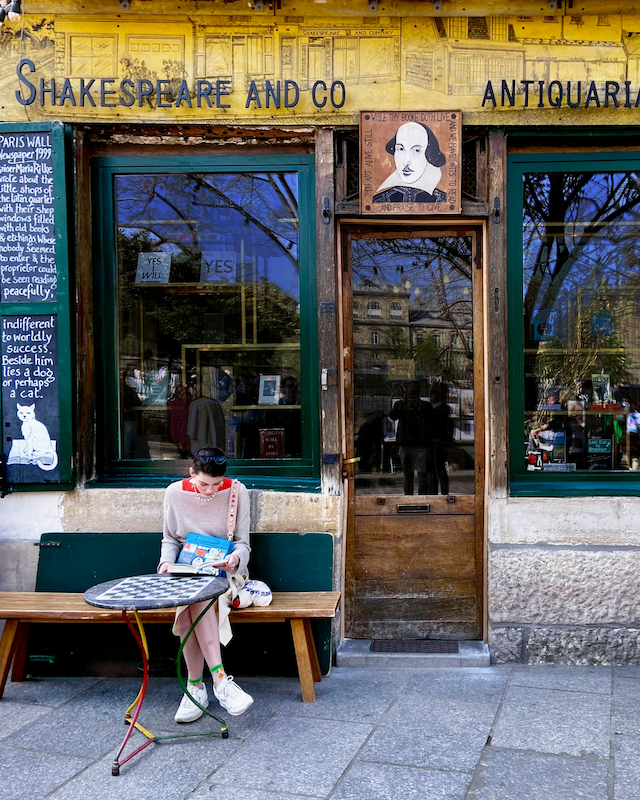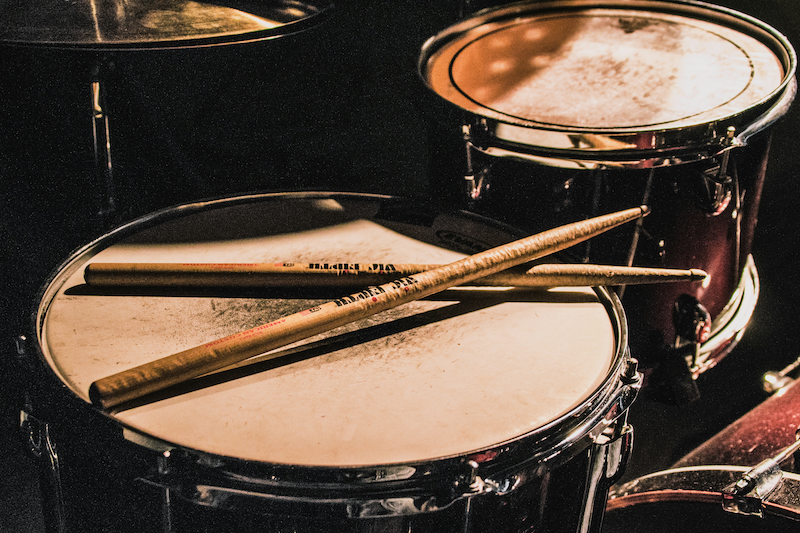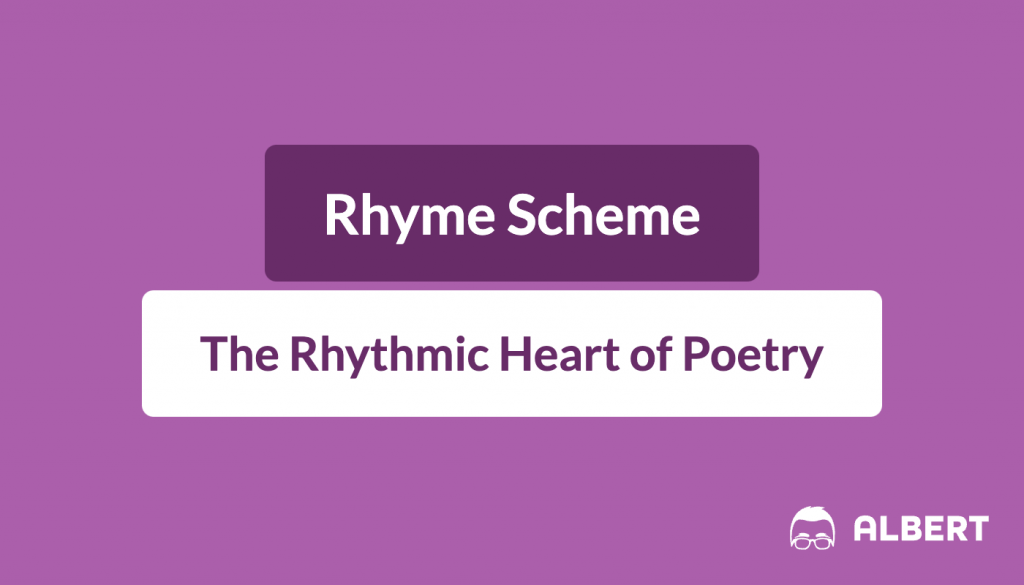What We Review
Introduction to Rhyme Scheme in Poetry
The rhyme scheme definition is a deliberate structural pattern in poetry where the words at the end of individual lines within a poem stanza are intentionally rhymed with words at the end of other lines within the same stanza. Rhyme scheme is notated in poetry by using letters of the alphabet.
The first set of lines that rhyme with one another are notated with the letter “a”. The second set of lines that rhyme with one another and use a different rhyme are notated with the letter “b”. Edgar Allan Poe’s poem, “The Raven,” is a great rhyme scheme example. The rhyme scheme is ABCBBB:
“Once upon a midnight dreary, while I pondered, weak and weary, A
Over many a quaint and curious volume of forgotten lore— B
While I nodded, nearly napping, suddenly there came a tapping, A
As of someone gently rapping, rapping at my chamber door. B
“’Tis some visitor,” I muttered, “tapping at my chamber door— B
Only this and nothing more.” B
Poe, Edgar Allan. “The Raven.” Poetry Foundation, https://www.poetryfoundation.org/poems/48860/the-raven. Accessed 29 Jan. 2024.
The purpose of the rhyme scheme in a poem is to establish the tone and mood as well as emphasize the central message of the poem. In “The Raven” poem above, Poe maintains this rhyming pattern to signify “Lenore”, the narrator’s love who has died and whom the narrator is grieving. By continuing to end the second, fourth, fifth, and sixth lines of each stanza with words that rhyme with “Lenore”, Poe is emphasizing the all-encompassing grief that the narrator feels over the loss of a loved one.
Rhyme Scheme Examples: Exploring Patterns and Forms
There are many different types of rhyme schemes. For example, rhyming couplets consist of a pair of lines written sequentially that rhyme with one another. Shakespeare uses rhyming couplets often to end his love sonnets, such as Sonnet 18:
“So long as men can breathe or eyes can see,
So long lives this and this gives life to thee.”
There is also alternating rhyme (ABAB), enclosed rhyme (ABBA), triplet rhyme (AAA), monorhyme (AAAA), and villanelle (ABA).
In addition to these rhyming patterns for individual stanzas, there are specific poetry forms that build off of these rhyme scheme patterns. For example, a Shakespearean sonnet uses an alternating rhyme scheme for the first 12 lines and a rhyming couplet for the last two lines. On the other hand, a haiku, one of the shortest poetic forms at only three lines long, follows the villanelle rhyme scheme but also only allows a certain number of syllables per line, adding to its complexity. A limerick is yet another poetic form that is based loosely on the enclosed rhyme format with one additional line at the beginning (AABBA).
Each of these forms has a unique purpose in communicating a different message to the reader. In his sonnets, Shakespeare wanted to express his love through poetry by using highly figurative language, but he also believed strongly in forming a balanced and intricate poetic structure to enforce the complex nature of his love.
Rooted in Japanese history, the haiku is intended to mimic the emotional impact of brief moments of insight. Therefore, the poem relies on very few words within a strict poetic structure to capture the brevity of these moments. Whatever the structure of the poem, rhyme scheme plays a crucial role.

Sonnet Rhyme Schemes: A Case Study
As stated previously, William Shakespeare wrote over 100 sonnets, each one following a strict, alternating rhyme scheme for the first 12 lines and a rhyming couplet for the last two lines in order to mirror the complex and intricate nature of love. While Shakespeare’s sonnets are the most well-known of the sonnet forms, there are two more sonnet rhyme schemes: Petrarchan and Spenserian.
Petrarchan Sonnets
Petrarchan sonnet rhyme scheme follows a ABBAABBA; CDECDE or CDCDCD rhyme scheme. Spenserian sonnet rhyme scheme follows an ABAB, BCBC, CDCD, EE rhyme scheme. Petrarch was an Italian poet during the Italian Renaissance who wrote primarily about love being just out of reach. Sir Thomas Wyatt makes use of Petrarchan form and subject in his poem, “Whoso List to Hunt”:
“Whoso list to hunt, I know where is an hind,
But as for me, hélas, I may no more.
The vain travail hath wearied me so sore,
I am of them that farthest cometh behind.”
Wyatt, Sir Thomas. “Whoso List to Hunt.” Poetry Foundation. https://www.poetryfoundation.org/poems/45593/whoso-list-to-hunt-i-know-where-is-an-hind. Accessed 30 Jan.2024
In this poem, the rhyme scheme follows an ABBA format in the first stanza, meaning that the first and fourth lines rhyme with one another while the second and third lines rhyme with one another. The message of the poem follows the theme of love being just out of reach as a “hind” (or deer) is compared to a woman that the speaker is hunting. Chasing this deer (or woman) has exhausted him and he is ready to give up.
Spenserian Sonnet
The Spenserian sonnet is named after Edmund Spenser, a British poet during the Elizabethan period. Spenserian sonnets are also usually on the topic of love, as seen in Sonnet 75:
“One day I wrote her name upon the strand,
But came the waves and washed it away:
Again I wrote it with a second hand,
But came the tide, and made my pains his prey.
“Vain man,” said she, “that dost in vain assay,
A mortal thing so to immortalize;
For I myself shall like to this decay,
And eke my name be wiped out likewise.”
Spenser, Edmund. “Amoretti LXXV: One Day I Wrote her Name.” Poetry Foundation. https://www.poetryfoundation.org/poems/45189/amoretti-lxxv-one-day-i-wrote-her-name. Accessed 14 Feb. 2024
In this poem, Spenser uses his own sonnet format of ABAB, which looks very similar to a Shakespearean sonnet; however, Spenser does not continue the second stanza with a CDCD rhyme scheme like Shakespeare would. Rather, the second stanza connects to the rhyme scheme of the first by following a BCBC rhyme scheme, continuing the rhyme from the second and fourth lines into the fifth and seventh lines. Spenser’s sonnet follows a similar theme as Shakespeare’s sonnets as the speaker claims that his love will not die as all humans do; rather she will live eternally through his sonnets.

The Nuances of Slant Rhyme in Poetic Rhythm
While exact rhymes are easy to spot (bat and rat), slant rhyme allows for similar sounding words to be paired with one another. Song writers do this all the time; for example, “My Shot” by Lin Manuel Miranda uses both exact rhymes and slant rhymes:
“I prob’ly shouldn’t brag, but dag, I amaze and astonish
The problem is I got a lot of brains but no polish […]
See, I never thought I’d live past twentyWhere I come from, some get half as many.”
Miranda uses exact rhyme by pairing the words “astonish” and “polish”, but he also uses slant rhyme by pairing the words “twenty” and “many”.
Meter in Poetry: Understanding its Role and Variations
What is meter in poetry? Meter in poetry provides the rhythm or the pulse of the poem. The definition of meter in poetry is the “pattern of beats in a line of poetry”. Meter is measured by “feet”, or stressed and unstressed syllables.
The five primary types of meter are iambs, trochees, spondees, anapests and dactyls. The meters with two-syllable feet are iambic, trochaic, and spondaic. The meters with three-syllable feet are anapests and dactyls. Shakespeare wrote all of his sonnets in iambic pentameter, which means that every line had five iambs, or ten syllables total.
Sonnet 116 provides an example of this:
“Let me not to the marriage of true minds
Admit impediments; love is not love
Which alters when it alteration finds,
Or bends with the remover to remove.”
Shakespeare, William. Sonnet 116. Poetry Foundation. https://www.poetryfoundation.org/poems/45106/sonnet-116-let-me-not-to-the-marriage-of-true-minds. Accessed 14 Feb 2024.
Iambic pentameter always starts with an unstressed syllable and is followed by a stressed syllable. Above, the stressed syllables are notated in bold.

Consonance, Alliteration, Repetition, and Assonance: Sound Devices in Poetry
Sound devices in poetry also play an important role in establishing the tone, mood, and overall message of the poem. A few examples of sound devices in poetry are consonance, alliteration, repetition and assonance.
Consonance in Poetry
Consonance in poetry occurs when words with the same consonant sound are used together, whether in the same line, across multiple lines, or at the end of lines to coincide with the rhyme scheme. An example of consonance is in William Blake’s “The Chimney Sweeper” poem wherein he repeats the consonant “t”:
“And so he was quiet, & that very night,
“And so he was quiet, & that very night,
As Tom was a-sleeping he had such a sight!”
Blake, William. “The Chimney Sweeper: When my mother died I was very young.” The Poetry Foundation. https://www.poetryfoundation.org/poems/43654/the-chimney-sweeper-when-my-mother-died-i-was-very-young. Accessed 14 Feb 2024.
Alliteration in Poetry
Alliteration in poetry occurs when words with the same first consonant letter are used sequentially in a line or several lines of poetry. An example of alliteration can be found in Emily Dickinson’s poem, “Behind me–dips Eternity”:
“Death but the Drift of Eastern Gray,
Dissolving into Dawn away”
Dickinson, Emily. “Behind me-dips Eternity.” All Poetry. https://allpoetry.com/Behind-Me–dips-Eternity. Accessed 14 Feb 2024.
Assonance in Poetry
Assonance in poetry occurs when words with the same vowel sounds are used together, whether in the same line, multiple lines, or and the end of lines. For example, “In a Garden” by Amy Lowell repeats the “i” sound throughout the first stanza.
“In granite-lipped basins,
Where iris dabble their feet
And rustle to a passing wind,
The water fills the garden with its rushing,
In the midst of the quiet of close-clipped lawns.”
Lowell, Amy. “In a Garden.” Poetry Foundation, 1 Jan. 2002, https://www.poetryfoundation.org/poems/42983/in-a-garden-56d221a5bfad9. Accessed 30 Jan. 2024.
Repetition in Poetry
Finally, repetition in poetry is fairly self-explanatory, but it is the intentional repetition of words, phrases, lines, or entire stanzas in order to focus the reader’s attention. A couple of examples of repetition can be found in Dylan Thomas’ poem, “Do Not Go Gentle Into That Good Night”:
“Do not go gentle into that good night,
Old age should burn and rave at close of day;
Rage, rage against the dying of the light.
Though wise men at their end know dark is right,
Because their words had forked no lightning they
Do not go gentle into that good night.”
Thomas, Dylan. “Do Not Go Gentle Into That Good Night.” Poetry Foundation. https://www.poetryfoundation.org/poems/46569/do-not-go-gentle-into-that-good-night. Accessed 14 Feb. 2024
In this poem, Thomas not only repeats individual words (rage, rage), but he also repeats an entire line throughout the poem: “Do not go gentle into that good night”. This repetition serves both the tone and mood by emphasizing the serious tone of the speaker’s charge to his listeners as well as a dark and frightening mood.

Analyzing Rhyme Schemes: Examples in Famous Poems
Now that you have background knowledge on how to identify a poem’s rhyme scheme, let’s put these skills together to analyze the rhyme scheme of Shakespeare’s Sonnet 18.
“Shall I compare thee to a summer’s day?
Thou art more lovely and more temperate:
Rough winds do shake the darling buds of May,
And summer’s lease hath all too short a date;
Sometime too hot the eye of heaven shines,
And often is his gold complexion dimm’d;
And every fair from fair sometime declines,
By chance or nature’s changing course untrimm’d;
But thy eternal summer shall not fade,
Nor lose possession of that fair thou ow’st;
Nor shall death brag thou wander’st in his shade,
When in eternal lines to time thou grow’st:
So long as men can breathe or eyes can see,
So long lives this, and this gives life to thee.”
Shakespeare, William. “Sonnet 18: Shall I compare thee to a summer’s day?” Poetry Foundation. https://www.poetryfoundation.org/poems/45087/sonnet-18-shall-i-compare-thee-to-a-summers-day. Accessed 14 Feb. 2024.
1. First, look at the end of the first two lines. Do they rhyme with one another, or not? In this case, the first two lines do not rhyme with one another, so they will be notated with different letters. When labeling the rhyme scheme, remember that each line is designated with a different letter of the alphabet, so the first line will be notated with a capital “A”, and the second line will be notated with a capital “B”.
2. Next, you will look at the next two lines. Do either of them rhyme with lines 1 or 2? If they do, pretend like you are playing a matching game and pair each line with its rhyming partner. In this instance, line 3 rhymes with line 1, and line 2 rhymes with line 4. Therefore, the rhyme scheme of this poem so far is ABAB.
3. Continue working through the poem, two lines at a time, and don’t assume that a poem will continue the same pattern throughout. In this poem, the last two lines form a rhyming couplet and rhyme with one another instead of an odd or even number line.
Conclusion: The Synergy of Rhyme and Meter in Poetry
Poetic structure is far more complex than we sometimes give credit. From rhyme scheme to meter to the overall poetic structure or use of poetic devices, poetry is not something that can be written or read speedily without deep consideration. However, knowing how to recognize and implement different rhyme schemes, sound devices, or types of meter not only increases one’s ability as a writer, but it also leads to a deeper understanding when reading poetry and leads us to appreciating the time and skill of these poets across the centuries.
For more practice analyzing rhyme and meter in poems, check out Albert’s Poetry course!








